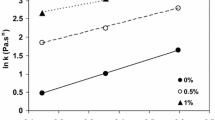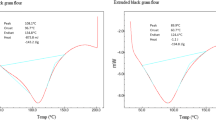Abstract
Using strong wheat flour in wafer batter leads to various defects in the prepared wafer sheet such as hard texture and uneven shape. Therefore, this study aimed to investigate the influence of different commercial enzymes including hemicellulase, protease, and α-amylase on the chemical and rheological properties of the wafer batter and textural characteristics of the wafer sheet made of strong flour. The solvent retention capacity (SRC) of the flour demonstrated that the enzyme treatment significantly impacted the SRC profiles whereby the lowest water SRC (47 ± 0.20%) was observed in the flour containing the hemicellulase enzyme. The results also showed that the lowest consistency coefficient (1.98 ± 0.12 K, Pa.sn) and the highest flow behavior index (0.752 ± 0.010) were observed in batter with added hemicellulase. This would indicate that the rheological properties in this batter had the most similarity to Newtonian fluids among all batters. According to the result, using hemicellulase or α-amylase enzymes in batter made of strong flour could help to produce lighter wafer sheets similar to regular wafer sheets prepared with soft flour. The results also confirmed that the use of hemicellulase and protease enzymes is a suitable way to resolve technological challenges arising from the use of strong flour in the wafer batter formulation.





Similar content being viewed by others
References
I.S. Dogan, Factors affecting wafer sheet quality. Int. J. Food Sci. Technol. 41(5), 569–576 (2006). https://doi.org/10.1111/j.1365-2621.2005.01117.x
M. Nasabi, B. Naderi, M. Akbari, T. Aktar, M. Kieliszek, M. Amini, Physical, structural and sensory properties of wafer batter and wafer sheets influenced by various sources of grains. LWT (2021). https://doi.org/10.1016/j.lwt.2021.111826
D. Manley, Wafer biscuits, in Manley’s technology of biscuits, crackers and cookies. (Woodhead Publishing, Sawston, 2011), pp.353–371
K.F. Tiefenbacher, The technology of wafers and waffles I: operational aspects (Academic Press, Cambridge, 2017)
M. Kenzhekhojayev, A. Kiyabayeva, Physico-mechanical indicators in waffle production using sorghum flour. ISJ Theor. Appl. Sci. 05(73), 606–610 (2019). https://doi.org/10.15863/TAS.2019.05.73.95
M. Nasabi, M. Labbafi, M. HadiNezhad, M. Khanmohammadi, A. Bagheri Garmarudi, Investigation of TiO2 nanoparticle efficiency on decolourisation of industrial date syrup. Int. J. Food Sci. Technol. 48(2), 316–323 (2013)
S. Ahmad, A. Naz, M. Usman, A. Amjad, I. Pasha, U. Farooq, Impediment effect of chemical agents (additives) on gluten development in cookie dough. J. Food Sci. Technol. (2022). https://doi.org/10.1007/s13197-021-05149-7
M. Nasabi, M. Labbafi, Thermal aggregation of egg white proteins as affected by saccharides. J. Food Bioprocess. Eng. 3(2), 110–115 (2020). https://doi.org/10.22059/jfabe.2020.307261.1060
A. Saqib, T. Ali, M. Ahmed, A. Hasnain, Effect of pentosans addition on pasting properties of flours of eight hard white spring wheat cultivars. J. Food Sci. Technol. 51(6), 1066–1075 (2014). https://doi.org/10.1007/s13197-012-0629-8
L. Garófalo, D. Vazquez, F. Ferreira, S. Soule, Wheat flour non-starch polysaccharides and their effect on dough rheological properties. Ind. Crop Prod. 34(2), 1327–1331 (2011). https://doi.org/10.1016/j.indcrop.2010.12.003
C. Cevoli, A. Evangelisti, P. Gradari, A. Fabbri, Storage of wafer cookies: assessment by destructive techniques, and non-destructive spectral detection methods. J. Food Eng. 336, 111209 (2023). https://doi.org/10.1016/j.jfoodeng.2022.111209
X. Rouau, M.L. El-Hayek, D. Moreau, Effect of an enzyme preparation containing pentosanases on the bread-making quality of flours in relation to changes in pentosan properties. J. Cereal Sci. 19(3), 259–272 (1994). https://doi.org/10.1006/jcrs.1994.1033
S. Susanna, P. Prabhasankar, Effect of different enzymes on immunogenicity of pasta. Food Agric. Immunol. 26(2), 231–247 (2015). https://doi.org/10.1080/09540105.2014.893999
T. Walter, H. Wieser, P. Koehler, Degradation of gluten in rye sourdough products by means of a proline-specific peptidase. Eur. Food Res. Technol. 240(3), 517–524 (2015). https://doi.org/10.1007/s00217-014-2350-5
G. Wei, E. Helmerhorst, G. Darwish, G. Blumenkranz, D. Schuppan, Gluten degrading enzymes for treatment of celiac disease. Nutrients 12(7), 2095 (2020). DOI:https://doi.org/10.3390/nu12072095
T. Hejrani, Z. Sheikholeslami, A. Mortazavi, M.G. Davoodi, M. Karimi, M. Ranjbar, The combination effect of amylase and lipase on improving the quality, and rheological and sensory properties of partially baked frozen Barbari bread. J. Nutr. Sci. Food Technol. 9(3), 53–62 (2014)
M.E. Tkeshelashvili, G.A. Bobozhonova, M.A. Ananiev, The use of high-protein flour from sunflower Grist” Bioprotein” for the development of vegetarian Food Products. J. Food Chem. Nanotechnol. 8(1), 21–25 (2022). https://doi.org/10.17756/jfcn.2022-122
S.S. Sahi, Applications of natural ingredients in baked goods, in Natural food additives, ingredients and flavourings. (Woodhead Publishing, Sawston, 2012), pp.318–332
M. Akbari, S.H. Razavi, M. Kieliszek, Recent advances in microbial transglutaminase biosynthesis and its application in the food industry. Trends Food Sci. Technol. (2021). https://doi.org/10.1016/j.tifs.2021.02.036
AACC International, Approved methods of analysis. Method 56-11.01, 11th edn. (AACC International, St. Paul, 2010)
S. Mert, S. Sahin, G. Sumnu, Development of gluten-free wafer sheet formulations. LWT-Food Sci. Technol. 63(2), 1121–1127 (2015). https://doi.org/10.1016/j.lwt.2015.04.035
M. Akbari, M.H. Eskandari, Z. Davoudi, Application and functions of fat replacers in low-fat ice cream: a review. Trends Food Sci. Technol. 86, 34–40 (2019). https://doi.org/10.1016/j.tifs.2019.02.036
F. Salehi, M. Kashaninejad, Texture profile analysis and stress relaxation characteristics of quince sponge cake. J. Food Meas. Charact. 12(2), 1203–1210 (2018). https://doi.org/10.1007/s11694-018-9734-3
Q. Saleem, Mechanical and fracture properties for predicting cracking in semi-sweet biscuits. Int. J. Food Sci. Technol. 40(4), 361–367 (2005)
A.V.A. Resurreccion, Consumer sensory testing for food product development, in Developing new food products for a changing marketplace, 2nd edn., ed. by A.L. Brody, J.B. Lord (CRC Press, Boca Raton, 2007)
Z. Zhang, X. Fan, X. Yang, C. Li, R.G. Gilbert, E. Li, Effects of amylose and amylopectin fine structure on sugar-snap cookie dough rheology and cookie quality. Carbohydr. Polym. 241, 116371 (2020). https://doi.org/10.1016/j.carbpol.2020.116371
M. Kweon, L. Slade, H. Levine, D. Gannon, Cookie-versus cracker-baking—what’s the difference? Flour functionality requirements explored by src and alveography. Crit. Rev. Food Sci. Nutr. 54(1), 115–138 (2014). https://doi.org/10.1080/10408398.2011.578469
Q. Zhang, Y. Zhang, Y. Zhang, Z. He, R.J. Peña, Effects of solvent retention capacities, Pentosan content, and dough rheological properties on sugar snap cookie quality in Chinese soft wheat genotypes. Crop Sci. 47, 656–664 (2007)
Y. Zhang, Q. Zhang, Z. He, Y. Zhang, G. Ye, Solvent retention capacities as indirect selection criteria for sugar snap cookie quality in Chinese soft wheats. Aust. J. Agric. Res. 59, 911–917 (2008). https://doi.org/10.1071/AR07442
A. Colombo, G.T. Pérez, P.D. Ribotta, A.E. León, A comparative study of physicochemical tests for quality prediction of Argentine wheat flours used as corrector flours and for cookie production. J. Cereal Sci. 48, 775–780 (2008). https://doi.org/10.1016/j.jcs.2008.05.003
A.E. Duyvejonck, B. Lagrain, B. Pareyt, C.M. Courtin, J.A. Delcour, Relative contribution of wheat flour constituents to solvent retention capacity profiles of european wheats. J. Cereal Sci. 53(3), 312–318 (2011). https://doi.org/10.1016/j.jcs.2011.01.014
M. Wang, T. van Vliet, R.J. Hamer, Effect of pentosans on gluten formation and properties, in The gluten proteins, Wageningen University and research. (2004). https://doi.org/10.1039/9781847552099-00361
G. Awalgaonkar, S. Sarkar, S. Bankar, R.S. Singhal, Xylanase as a processing aid for papads, an indian traditional food based on black gram. LWT-Food Sci. Technol. 62(2), 1148–1153 (2015). https://doi.org/10.1016/j.lwt.2015.02.034
B. Ismail, H. Mohammed, A.J. Nair, Influence of proteases on functional properties of food, in Green Bio-processes. (Springer, Singapore, 2019), pp.31–53
A. Amore, V. Faraco, Enzymes for food and beverage industries: current situation, challenges and perspectives, in Advances in food biotechnology. (Wiley, Hoboken, 2015), pp.165–190
J.H. Kim, T. Maeda, N. Morita, Effect of fungal α-amylase on the dough properties and bread quality of wheat flour substituted with polished flours. Food Res. Int. 39(1), 117–126 (2006). https://doi.org/10.1016/j.foodres.2005.06.008
J. Rodríguez García, C.A. Puig Gómez, A. Salvador, M. Hernando Hernando, Functionality of several cake ingredients: a comprehensive approach. Czech J. Food Sci. 31(4), 355–360 (2013)
E. Gallagher, T.R. Gormley, E.K. Arendt, Crust and crumb characteristics of gluten free breads. J. Food Eng. 56(2–3), 153–161 (2003). https://doi.org/10.1016/S0260-8774(02)00244-3
B. Tufan, S. Sahin, G. Sumnu, Utilization of legume flours in wafer sheets. Legume Sci. 2(1), e12 (2020). https://doi.org/10.1002/leg3.12
B.A. Law, R. Whitehurst, Enzymes in food technology (Sheffield Academic Press, Sheffield, 2002), pp.1–30
I.K. Mohammed, M.N. Charalambides, J.G. Williams, J. Rasburn, Modelling the deformation of a confectionery wafer as a non-uniform sandwich structure. J. Mater. Sci. 48(6), 2462–2478 (2013). https://doi.org/10.1007/s10853-012-7034-6
S. Mert, Effect of different flours on quality of gluten-free wafer sheet (Master’s thesis) (2014)
I.S. Dogan, O. Yildiz, R. Meral, Optimization of corn, rice and buckwheat formulations for gluten-free wafer production. Food Sci. Technol. Int. 22(5), 410–419 (2016). https://doi.org/10.1177/1082013215610981
M. Kara, D. Sivri, H. Köksel, Effects of high protease-activity flours and commercial proteases on cookie quality. Food Res. Int. 38(5), 479–486 (2005). https://doi.org/10.1016/j.foodres.2004.09.012
Author information
Authors and Affiliations
Corresponding authors
Ethics declarations
Conflict of interest
The authors declare that there are no conflicts of interest regarding the publication of this paper.
Additional information
Publisher’s Note
Springer Nature remains neutral with regard to jurisdictional claims in published maps and institutional affiliations.
Rights and permissions
Springer Nature or its licensor (e.g. a society or other partner) holds exclusive rights to this article under a publishing agreement with the author(s) or other rightsholder(s); author self-archiving of the accepted manuscript version of this article is solely governed by the terms of such publishing agreement and applicable law.
About this article
Cite this article
Naderi, B., Nasabi, M., Akbari, M. et al. Effect of enzymatic treatment on rheological properties of wafer batter and textural properties of wafer sheet. Food Measure 17, 2213–2223 (2023). https://doi.org/10.1007/s11694-022-01760-0
Received:
Accepted:
Published:
Issue Date:
DOI: https://doi.org/10.1007/s11694-022-01760-0




